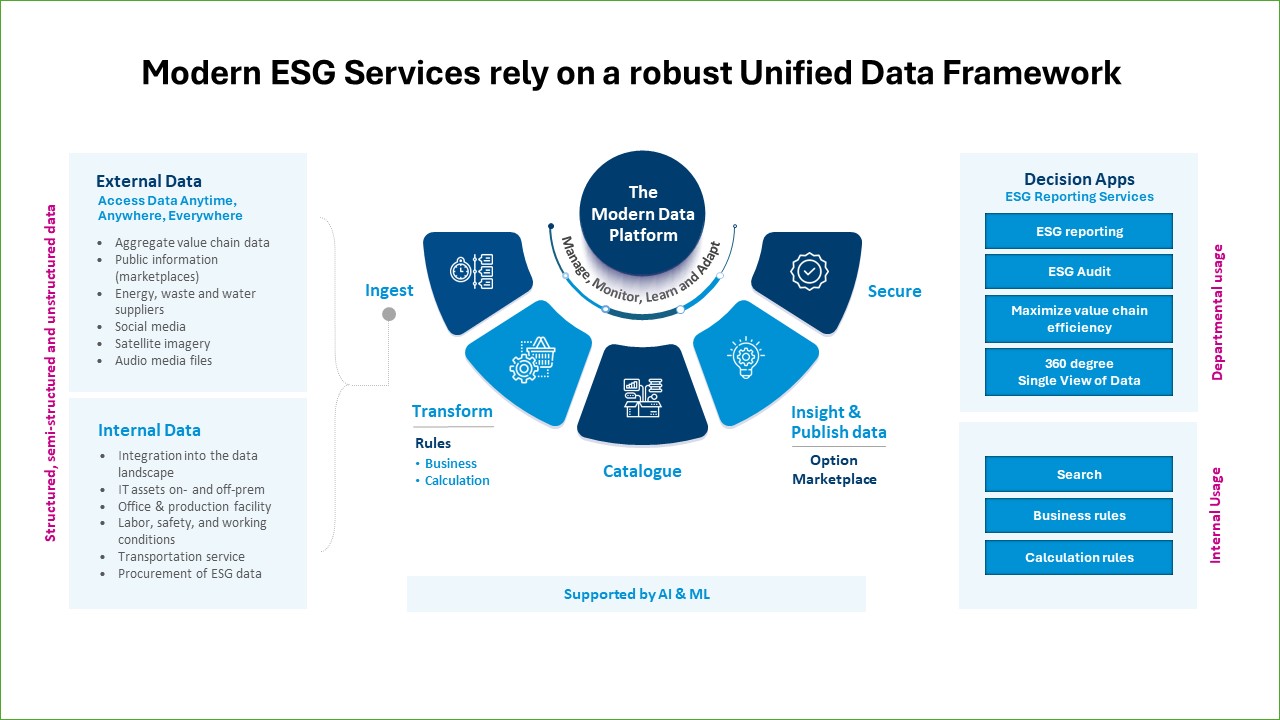Efficient Data Governance for Driving Effective ESG Reporting
Data serves as the lifeblood of Environmental, Social, and Governance (ESG) reporting, enabling companies to deliver accurate ESG reports and ensure compliance with audit regulations. However, ESG data management can be challenging. Many organizations face challenges with data governance because they lack the appropriate frameworks, tools, or expertise to handle it effectively.
Over the last year, insights gathered from customers and public forums echo a consistent sentiment: technology and personnel resources are not the primary obstacles; the focus remains on optimizing internal processes and establishing the right data governance framework to ensure accurate and efficient ESG reporting results.
In the blog “The Data Risk Factor: The Silent Threat in ESG Reporting” we learnt about the challenges in ESG reporting. In this one, we will get to know how robust data governance and advanced technologies can streamline ESG risk reporting.
What is data governance?
Data governance is the framework that covers the overall data management within an organization. It involves defining and implementing policies, procedures, and standards to ensure that data is accurate, complete, secure, and accessible to those who need it. A data governance framework also includes roles and responsibilities for data management, data quality control measures, metadata management, and compliance with regulations and best practices. Essentially, data governance aims to establish protocols for ESG data management—how data is collected, stored, used, and maintained—to support business objectives effectively.
Roles in data governance
Before we dive into the data governance framework through the lens of ESG, it should be highlighted that these projects are a team effort that spans the organization. Departments are required to collaborate to deliver the expected commitments. Therefore, it becomes relevant and equally important to address data governance and related job roles to maintain momentum in learning and adapting the modern ESG platform.
When considering ideal data governance implementation, key roles like managers, stakeholders, and data champions often surface. However, three pivotal roles every organization should grasp are:
- Data owner (meaning of data)
Stakeholders in every department are accountable for ESG data set classification and play an active role in applying business rules to ensure data quality. Their responsibilities include securing accessibility, retention, and data quality and setting up reporting and audit services.
- Data steward (controlling access)
A subject expert overseeing the ESG data set to ensure compliance with mandatory standards. They focus on data classification, protection, use, and quality, working closely with the Data Owner. Data Stewards must help break down data silos, understand ESG data calculation rules, and can be categorized into business, operational, or more technical roles.
- Data custodian (curating data)
They are tasked with implementing and upholding security controls for a designated data set to meet the requirements outlined in the data governance framework.
Each role is key in maintaining high-quality and usable data within an organization, contributing to effective data governance practices. Establishing a data governance framework where employees can evolve, learn, and adapt by adjusting the data to secure the right data quality. This guarantees ESG reporting and subsequent delivery of data origin for audit purposes.
Getting started
When looking to tackle ESG reporting and audit mandates, investing in a modern ESG data management framework that offers a range of capabilities is essential. Here are the key features to consider:
Data catalog
Look for a data catalog service that provides data descriptions using metadata features to achieve an overview of the organization’s data landscape. It provides data discovery and gathering and data lineage, which involves tracing the origins of data and how it has changed over time. Furthermore, it offers insight into where data is stored, what changes were made over time, and how it is used. In addition, there are rules and permissions to safeguard the data itself.
With a data catalog service, data is ingested and transformed faster, allowing teams to share insights and collaborate more effectively. These teams can also access purpose-built reporting and audit services. Overall, it enhances data governance practices.
Data discovery and ingesting
An ideal solution should enable data discovery across the entire value chain, including structured, semi-structured, and unstructured data. Look for a technology that provides comprehensive metadata connectivity, supporting various data file formats, legacy technologies, and stored procedures in database applications.
Data transformation
The features of a data governance framework play a key role in defining essential data elements and ensuring consistency across the enterprise. Here are some examples:
- Choosing to report emissions in kilograms requires a conversion process when suppliers submit data in pounds.
- Utilizing metadata enhances understanding of suppliers’ materials by mentioning origin and emission information, which facilitates easy tracking of data sources for comprehensive traceability.
- Introducing a “parking lot” function for incoming data involves temporarily storing data that does not meet predefined requirements. This allows business owners to manually verify or make changes before advancing to the next stage.
Data trust
Building trust in your data is crucial, especially regarding audits. Data quality capabilities are essential in this regard, allowing data lineage information to be overlaid on the actual data. Advanced solutions leverage natural language processing, enabling business users to define simple data quality rules without requiring programming experience. These rules can then be executed against each connected source, providing an immediate view of data quality.
Single view of data
It is the ability to create, maintain, and govern a single, authoritative source of reference data within an organization. This involves establishing standardized and consistent data definitions, formats, and structures to ensure data quality, accuracy, and reliability across systems and processes. Master data management (MDM) enables businesses to achieve a unified view of data, allowing users to feed the data into an ESG data lake or warehouse.
While a data catalog organizes various data assets across the organization, MDM focuses on managing the core business entities, including customers’ data, products, suppliers’ information, etc. It is worth mentioning that data catalog and data management systems don’t have to be mutually exclusive options. Many organizations see benefits in utilizing both systems.
Data democratization (optional)
Look for solutions offering a self-service data marketplace that gives the business access to clean and trusted data. This empowers different business units to integrate ESG data into their operating model decisions, enabling strategic ESG action and progress. Additionally, the data marketplace can be used to perform attestations required for regulatory reporting.
Automated data consumption
Cloud-based data marketplaces automate data consumption, allowing users outside the data science team to browse and select relevant data sets. This feature is particularly beneficial for companies dealing with a high volume of ESG-related data requests, streamlining the data consumption process.
By considering these capabilities, you can find an ESG reporting solution that meets your needs and helps you navigate the complexities of reporting mandates effectively.
How might an ESG framework appear?
A modern ESG framework integrates environmental, social, and governance factors into business strategies to drive sustainability and transparency. The advanced features encompass data cataloging, data ingesting, transformation, trust-building, insights, and publishing data, and democratization for reporting and audit purposes.

Figure 1: A unified data framework
Conclusion
Data governance serves as a vital framework for managing data effectively within organizations, ensuring accuracy, security, and accessibility. Key roles such as data owner, data steward, and data custodian are essential for maintaining quality data and supporting effective governance practices. Investing in a modern ESG framework with features like data cataloging, data transformation, and data trust is crucial for successfully tackling ESG reporting and audit mandates while fostering data-driven decision-making and compliance.
More from Tom Christensen
Leveraging the right cloud technology with appropriate strategies can lead to significant cost…
It pays to be data driven. Research conducted by Forrester1 reveals that companies advanced…
Welcome to our discussion on responsible AI —a transformative subject that is reshaping technology’s…
At our recent roundtable event in Copenhagen, we hosted engaging discussions on accelerating…
Latest Blogs
Core banking platforms like Temenos Transact, FIS® Systematics, Fiserv DNA, Thought Machine,…
We are at a turning point for healthcare. The complexity of healthcare systems, strict regulations,…
Clinical trials evaluate the efficacy and safety of a new drug before it comes into the market.…
Introduction In the upstream oil and gas industry, drilling each well is a high-cost, high-risk…




